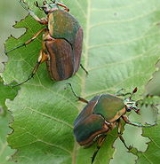
Cotinis nitida
Encyclopedia
Cotinis nitida, also known as the green beetle, is a beetle
of the family Scarabaeidae
. It occurs in the southeastern part of the United States
. It is not easily distinguished from the related southwestern species, Cotinis mutabilis.
The green beetle is active during daylight hours. The adult is usually 15 millimetre long with dull, metallic green wings; its sides are gold and the head, legs and underside are very bright shiny green. Their habitat extends from Maine to Georgia, and as far west as Kansas, with possible population crossover in Texas with their western cousin, the figeater beetle
.
The green beetle is harmless; however, the larvae are considered pests when they cause damage to lawns.
Beetle
Coleoptera is an order of insects commonly called beetles. The word "coleoptera" is from the Greek , koleos, "sheath"; and , pteron, "wing", thus "sheathed wing". Coleoptera contains more species than any other order, constituting almost 25% of all known life-forms...
of the family Scarabaeidae
Scarabaeidae
The family Scarabaeidae as currently defined consists of over 30,000 species of beetles worldwide. The species in this large family are often called scarabs or scarab beetles. The classification of this family is fairly unstable, with numerous competing theories, and new proposals appearing quite...
. It occurs in the southeastern part of the United States
United States
The United States of America is a federal constitutional republic comprising fifty states and a federal district...
. It is not easily distinguished from the related southwestern species, Cotinis mutabilis.
The green beetle is active during daylight hours. The adult is usually 15 millimetre long with dull, metallic green wings; its sides are gold and the head, legs and underside are very bright shiny green. Their habitat extends from Maine to Georgia, and as far west as Kansas, with possible population crossover in Texas with their western cousin, the figeater beetle
Figeater beetle
Cotinis mutabilis, also known as the "green fruit beetle" or "fig beetle" and also as "junebug", is a member of the scarab beetle family. It belongs to the subfamily Cetoniinae, comprising a group of beetles commonly called flower chafers since many of them feed on pollen, nectar, or petals. Its...
.
Life cycle
The complete life cycle for the green beetle is one year. Once the mating process has taken place, the female will lay between 60 and 75 eggs underground during a two week period. The eggs, when first laid, appear white and elliptical in shape, gradually becoming more spherical as the larvae develop. The eggs hatch in approximately 18 days into small, white grubs. The grubs will grow to about 40mm and appear to be white with a brownish-black head and brown spiracles along the sides of the body. The larvae will molt twice before winter. Pupation occurs after the third larval stage, which lasts nearly nine months. The adults begin to appear in June after 18 days of the pupation period.The green beetle is harmless; however, the larvae are considered pests when they cause damage to lawns.

